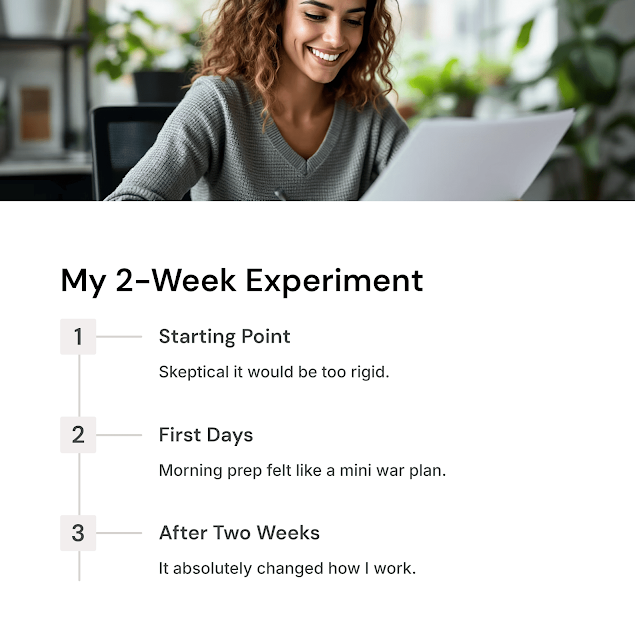Ever feel like your to-do list is laughing at you by 3 PM? You're not alone. Between constant notifications, back-to-back meetings, and just trying to squeeze in a lunch break, staying focused feels like chasing a unicorn. But what if you could tame your day—literally block it out—before chaos hits? That’s the magic of time blocking, and trust me, once you try it, there’s no going back.
This isn’t just another productivity hack. It’s a mindset shift backed by brain science, used by top performers like former Google CEO Larry Page and lauded by Harvard Business Review. Time blocking isn’t about doing more—it’s about doing what matters, when it matters, without burning out.
What is Time Blocking?
Time blocking is more than just scheduling. It’s a strategy—an intentional, pre-planned way to organize your day into clear, uninterrupted “blocks” of time dedicated to specific tasks. This technique encourages you to decide in advance what you'll work on and when, transforming your calendar into a visual plan for productivity. Unlike traditional to-do lists that focus on what needs to be done, time blocking focuses on when to do it.
The concept dates back decades but gained momentum when productivity powerhouses like Larry Page, co-founder of Google, publicly endorsed it. His daily routine—structured with intentional focus blocks—set the example that many tech CEOs, creatives, and even therapists now follow.
At its core, time blocking gives you control over your attention. You’re no longer letting your day happen to you; you’re designing it. Each hour is reserved with purpose. Meetings? Blocked. Deep work? Blocked. Coffee break? Yep—blocked.
The Psychology Behind Time Blocking
Why does time blocking work so well? It taps into the psychology of focus and habit. Research on attention span—like the studies from Harvard and MIT—shows that our brains struggle to stay in a state of “deep work” for long periods unless there’s a clear structure. Time blocking eliminates the ambiguity and decision fatigue that kills productivity.
| Psychological Benefit | How Time Blocking Helps |
|---|---|
| Increased Focus | Eliminates multi-tasking by dedicating full attention to one task at a time. |
| Reduced Anxiety | Knowing your day is pre-planned reduces the uncertainty that fuels stress. |
| Procrastination Control | Hard start times lower activation resistance. |
Key Benefits of Time Blocking
- Productivity Boost: Structured blocks reduce context switching, letting you get more done in less time.
- Improved Focus: Protected blocks create conditions for flow state.
- Less Stress: Visual plans give you a sense of control, which is deeply calming.
- Better Work–Life Balance: You literally schedule time for rest, family, and recovery.
My 2-Week Time Blocking Experiment
I didn’t expect much when I started using time blocking. Honestly, I thought it would be just another overly rigid system. But after two weeks of experimenting with 30-minute slots on Google Calendar, I can say one thing: it absolutely changed how I work. The first few days were rough—prepping every morning felt like a mini war plan—but once I built the habit, the payoffs were worth it.
Here's how I structured it: I blocked out deep work sessions, admin time, meals, workouts, and even social scroll breaks (because, let’s be real, we’re all human). I added 10-minute buffer blocks between every major session so if a meeting ran over or I needed to reset, it wouldn’t throw off my whole day.
Common Pitfalls and Fixes
| Pitfall | Fix |
|---|---|
| Over-scheduling | Leave flexible blocks and buffer time to accommodate surprises. |
| Rigid expectations | Treat your blocks as a guide, not a prison sentence. Adjust as needed. |
| Neglecting planning time | Set aside 10 minutes each morning or Friday afternoons for review. |
Practical Tips for Time Blocking
- Use priority-based scheduling: Place your most critical tasks in the first few blocks of the day.
- Include buffer time: Add at least 10–15 minutes between major tasks or meetings.
- Try supportive tools: Google Calendar, TickTick, and Pomodoro apps work great in sync with this method.
- Weekly review: Set a recurring Friday block to reflect and adjust next week’s plan.
Frequently Asked Questions (FAQ)
Nope! It works just as well for personal tasks—workouts, reading time, family dinner, even naps.
Nope. A paper planner or notebook works fine. But apps like Google Calendar and TickTick can streamline things.
You shift blocks around. That’s why buffer time is so important.
Absolutely. Many teams use shared calendars to block collaboration and solo work hours.
Depends on the task. For deep work, 90 minutes works great. Admin tasks? 30 minutes is often enough.
The review! Without weekly reflection, you miss the insights that make this process powerful.
If you've ever felt like time slips through your fingers no matter how hard you try to manage it, time blocking might just be your secret weapon. It’s not about becoming a robot—it's about honoring your priorities and building a rhythm that works for you. Try it for just two weeks. You might be surprised how much calmer, clearer, and more confident you feel at the end of each day.
Related Resources
- Arcush – Time Blocking Explained
- Calendar.com – How Time Blocking Works
- YouTube – Time Blocking for Productivity (Thomas Frank)
- Asana – Time Blocking in Practice
- Harvard Business Review – How to Actually Do Deep Work







Post a Comment